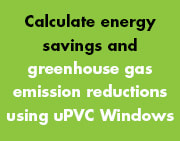How 'sustainable' a material or product is largely depends on how it is managed and used throughout its life cycle.

In any selection process, products should be assessed based on their merits in terms of fitness for purpose (performance), life cycle cost and life cycle impacts. In many applications, PVC is an ideal choice.
For uPVC windows, the key sustainability features include:
PVC is one of most well researched and tested materials in terms of environmental credentials. At least 60 reputable lifecycle assessments have been conducted on PVC since 1985 with half of these related to building applications. The weight of evidence from these studies confirms that PVC’s environmental credentials are sound compared to alternative materials.
For uPVC windows, the key sustainability features include:
- Durability - uPVC windows have an expected 35 year life span. Products have been formulated and tested to withstand the harsh Australian climate.
- Thermal Performance – uPVC windows can make a significant contribution to energy saving and greenhouse gas emission reduction throughout their life cycle as they have relatively low embodied energy compared to some alternatives and by reducing the operational energy required for heating and cooling buildings during their service life.
- Low Maintenance and Low Fuss – no re-painting or staining is required. Cleaning is simply with soapy water.
- Recyclable – offcuts from fabrication of uPVC windows in Australia are already being recycled here. At the end of life, uPVC windows can be fully recycled and reused for the production of new uPVC profile
PVC is one of most well researched and tested materials in terms of environmental credentials. At least 60 reputable lifecycle assessments have been conducted on PVC since 1985 with half of these related to building applications. The weight of evidence from these studies confirms that PVC’s environmental credentials are sound compared to alternative materials.
|
|
|
